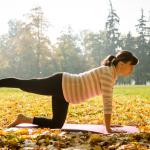
Exercise after pregnancy
Regular exercise after childbirth can have a great impact on your health. It will help you to return to your pre-pregnancy shape, increase your energy levels and balance out your hormones. You should ease back into exercise as your body heals after giving birth, before returning to your previous physical activity levels. Recovery time will be different for all mothers, as it depends on delivery type and existing muscle strength in your pelvic floor and abdomen.
When to start and types of exercise
It is recommended that you consult with your doctor or midwife before you start postnatal exercises. Generally, gentle pelvic floor muscle strengthening, and abdominal muscle bracing are recommended to start after your baby is born as they can help you recover. You can start gentle walking after a week or so when your pain and discomfort allows.
Other exercises that are safe to reintroduce after pregnancy include:
-
swimming (once bleeding has stopped)
-
yoga
-
pilates
-
low impact aerobics
-
light weight training
-
cycling
If you have abdominal separation, you should avoid sit ups, crunches, high impact or strenuous exercises and lifting anything heavier than your baby. Consult with your doctor, midwife or Physiotherapist on how to progress your exercises.
You may not feel like doing any exercise in the first few weeks or months due to the demands of motherhood. During this time, you can try doing your pelvic floor exercises to strengthen those muscles for when you do feel like exercising.
Postnatal exercise guidelines
According to the Continence Foundation of Australia, there are a few ways that you can reintroduce exercise into your routine after childbirth. Please note these are guidelines, and you should consult your doctor or physiotherapist for more individual recommendations.
|
Postnatal time |
Exercise options |
|---|---|
|
0-3 weeks |
Light walking |
|
3-8 weeks |
Low impact aerobics Light gym program – no breath holding Abdominal muscle bracing Pelvic floor exercises |
|
8-12 weeks |
Same as above, but gradually increase intensity and weight Abdominal muscle bracing Pelvic floor exercises |
|
12-16 weeks |
Consider visiting a physiotherapist for a check on abdominal and pelvic floor muscles. This is useful before returning to high impact exercise. |
|
16+ weeks |
Let your body be your guide. |
It is common for women to have bladder problems after birth. If you experience any urine leakage during activity or exercise, you can try activating the muscles before starting, for example before you cough or lift something. You should see your GP if you experience bladder leakage more than 3 months after birth.
For more information on returning to exercise, please visit: The Royal Woman’s Hospital Victoria
Related Articles:
Healthy Eating for a Healthy Pregnancy
Healthy Weight Gain in Pregnancy
[Continence foundation of Australia, 2021; Pregnancy, Birth and Baby, 2021; Raising Children, 2020; The Pregnancy Centre, 2022.]
Related Topics



